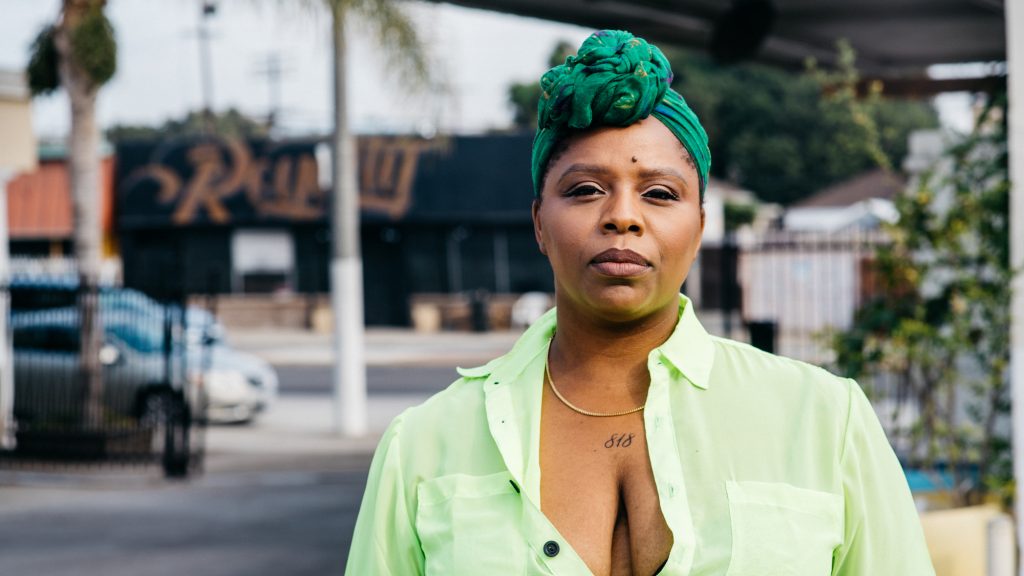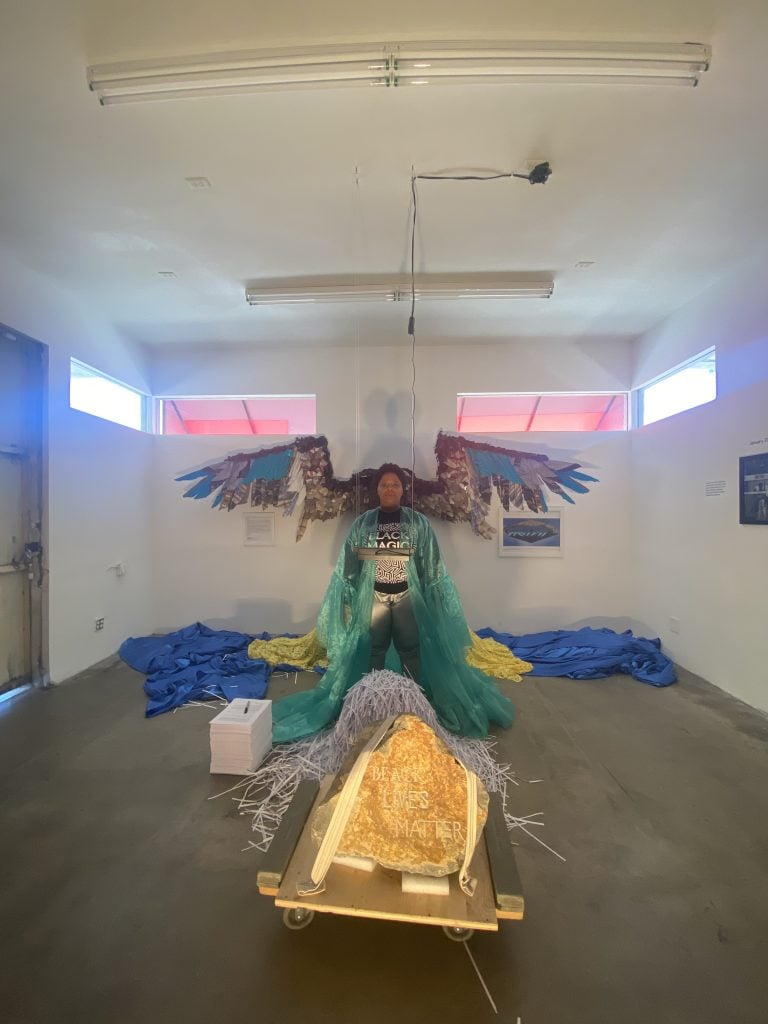People
Black Lives Matter Co-Founder Patrisse Cullors Mourns Ahmaud Arbery in Her Latest Performance—and Offers Some Activist Advice for the Art World
The artist and activist debuted her new performance in Los Angeles.

The artist and activist debuted her new performance in Los Angeles.

Janelle Zara

Patrisse Cullors, the performance artist and activist best known for co-founding Black Lives Matter in 2013, unveiled a new work on Saturday in collaboration with UCLA’s Fowler Museum. The performance piece, A Prayer for the Runner, honors the life of Ahmaud Arbery, a 25-year-old who was murdered in Georgia this year for the crime of jogging while black.
Conceived during our era of social distancing, A Prayer for the Runner debuted on a Zoom webinar as a two-channel video. On one side of a split screen, Cullors appeared in a candlelit room, barefoot, dressed in a gauzy emerald robe and silver metallic pants, the words “BLACK POWER” written across her black t-shirt. Writing in black marker on a knee-high stack of blank paper, she presented “LAPD BUDGET” to the viewer as a sacrificial offering, then fed it through a shredder suspended from the ceiling. One by one, as she shredded “JAILS,” “PRISONS,” and “POLICE,” the sheets momentarily held their shape in midair as they fell out of the machine, shattering to pieces as they landed on the growing mound of shreds below. In the background, a pair of outstretched wings hung on the wall.
“There’s a collective prayer,” Cullors’s voice spoke out from the other half of the splitscreen, flowing in a poet’s cadence. “And that prayer is grounded in the idea and the belief that one day we will be free.” She invoked the spirits of those recently lost to white supremacy by saying their names aloud: Ahmaud Arbery, Breonna Taylor, and George Floyd. “You did not deserve this,” she said, the words appearing and disappearing in a hazy field of digital stars. The prayer repeated several times, always ending not in an “amen” but an “ashe,” the Yoruba invocation of power and energy.
A Prayer for the Runner is a performative extension of the growing activist movement to defund the police, an increasingly urgent call to governments at all levels to abolish a historically violent institution. For an art world still seeking ways to make meaningful contributions: “We’re also calling on gallerists, and museum owners and directors,” Cullors said in the post-performance chat with fellow organizer Melina Abdullah. “Look at who you’re hiring as your law enforcement and start breaking ties and breaking contracts. That is what’s going to get us closer to freedom.”

Post-performance portrait at Crenshaw Dairy Mart. Courtesy of Patrisse Cullors
Cullors, an LA native, identifies as a queer Black woman and prison abolitionist. She’s spent the past 20 years navigating the intersection of those spaces, merging art with activism. Before co-founding Black Lives Matter, she formed the advocacy organization Dignity and Power Now for incarcerated people, in 2012. And after graduating from the University of Southern California’s MFA program, in 2019, she also co-founded the Crenshaw Dairy Mart art space in Inglewood, Los Angeles, and launched an MFA program of her own design at Prescott College in Arizona. Titled Social and Environmental Arts Practice, it dissolves the distinction between art and social justice.
“The work that I do comes from a Black arts tradition,” she said, citing Black artists of the 1960s and ’70s, including Black Panther Party minister of culture Emory Douglas, whose work was an inherent part of a larger movement. “The Panthers understood that they needed to impact politics, the economy, and culture.”
In her own practice, Cullors’s adaptations of ritual elements in West African traditions illustrate an overlooked aspect of Black Lives Matter as an organization: its emphasis on spirituality as a restorative mechanism, a counterbalance to the emotional toll of continuously losing Black lives. “Every time someone is stolen from us[…], it’s like a piece of me was stolen,” she said. “Both my political practice and my artistic practice make me feel like I’m putting parts of me together again.”
Her performances often center on themes of reclaiming both physical and mental space, and make room for Black joy in the face of relentless Black death. It calls back to Audre Lorde’s description of the importance of self care to the movement: “It is self-preservation, and that is an act of political warfare.” Wellness ingredients and treatments find their way into Cullors’s work: Her MFA thesis show, “Respite, Reprieve and Healing: An Evening of Cleansing,” included Black performers, dressed in white, washing one another’s hair with coconut milk and honey, while Cullors’s body lay submerged in a tub of Epsom salt. It contained the meditative repetition of sounds and gestures that Cullors describes as important to her political and artistic practices, “Mostly because you don’t get it the first time,” she said. “I think when we repeat something, it means something different, and it feels different each time.”
And that is the story of so many progressive movements. Across the arc of history, they repeat themselves countless times, and each successive generation carries them forward slightly louder, moving in a slightly new direction.
The day after Cullors’s performance, in lieu of LA’s annual Pride Parade, thousands marched in solidarity with Black trans lives. The march reverberated with the affects of both ritual and performance art: costume, dance, the burning of Palo Santo. Demonstrators called their invocations to George Floyd, Breonna Taylor, and to the many others lost: Say his name. Say her name. Say their name. And it hummed with the rhythmic repetition of a mantra that, after seven years, has reached a new a critical mass, finally achieving mainstream recognition as the definitive civil rights movement of our time: Black lives matter. Black lives matter. Black lives matter.